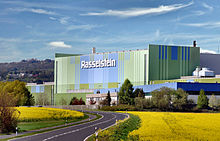ThyssenKrupp Rasselstein
Coordinates: 50 ° 25 ′ 55.1 ″ N , 7 ° 26 ′ 6.6 ″ E
The ThyssenKrupp Rasselstein GmbH , based in Andernach is a subsidiary of ThyssenKrupp Steel Europe AG. Thyssenkrupp Rasselstein GmbH is the only German tinplate manufacturer . At the world's largest production site for packaging steel , Rasselstein produces tin-plated tinplate, thin sheet and specially chrome-plated thin sheet with a thickness of 0.100 to 0.499 mm. The company employed 2,373 people in the 2010/2011 financial year (as of September 30, 2012) and achieved sales of EUR 1,384 million with sales of 1.4 million t of refined and unprocessed material. Thyssenkrupp Rasselstein GmbH looks after 400 customers in more than 80 countries, making it one of the three largest tinplate suppliers in Europe.
history
The name Rasselstein is first mentioned in 1665 and is traced back to the "rattling stones" of a quarry in the lower Wiedtal. Between 1748 and 1752 was Johann Friedrich Prince Alexander of Wied the mills to a metallurgical expand a sheet metal hammer and a small iron factory, 1,751 people had to Salpeterhütte , a boring machine , a powder mill , a potash plant and a scarlet dyeing it.
The company was leased to Heinrich Wilhelm Remy from Bendorf for ten years in 1760 . The first blast furnace was built in 1761 , and Germany's first sheet rolling mill was built by 1770 . In 1784 Carl Wilhelm Remy bought the plant. The Rasselstein quickly became a major supplier of machined iron and steel products. In 1824 the first puddle furnace and a rod rolling mill are built. In 1835, Rasselstein supplied, among other things, the rails for the first German railway line from Nuremberg to Fürth . It was the only German plant that was able to roll rails in the required length and manufacture them in the right quality. In 1842, Rasselstein supplied all parts for the Mannheim Chain Bridge. The continuous production of tinplate began in 1856 . In 1883 the first Bessemer pear was put into operation in Germany, four years later the blast furnace was blown out and ore smelting stopped. In the following years the steel production was modernized and in 1893 two Siemens-Martin furnaces were installed.
From 1919 to 1920 the Wiedhafen was built at the mouth of the river Wied . In Andernach, the Remy steel strip mill was opened in 1921 by Zypen & Co. put into operation. Until 1922, the Remy family was the sole owner of the Rasselsteiner Eisenwerke. In 1923 Otto Wolff took a third share in Rasselstein, in 1934 he then took over the majority of the shares and became chairman of the supervisory board. In that year the world's first electrolytic strip tinning line was built, the basis for the modern packaging material tinplate. In 1938 Otto Wolff became the sole owner of the Rasselstein. The first cold rolling mill for wide strip on a reversing stand went into operation.
After the re-establishment in 1951 as Stahl- und Walzwerke Rasselstein / Andernach AG , the administration high-rise in Neuwied was built in 1952 and between 1953 and 1955 a three-stand tandem mill, electrolytic broadband tinning and the first continuous annealing furnace in Europe were built. Thyssen took over 25 percent of the company in Rasselstein in 1958. In the years 1959 to 62, the hot operation in Neuwied was shut down, in 1960 the first five-stand tandem mill in Germany was inaugurated. In 1962 Thyssen increases its stake to 50 percent.
In 1990 the Otto Wolff Group was taken over by Thyssen. The merger of Krupp Hoesch AG and the tinplate operations of Rasselstein AG creates Rasselstein Hoesch GmbH. In 2004 the name was changed to Rasselstein GmbH. Since 2005, Rasselstein has been the world's largest production site for tinplate. On February 15, 2012, the name was changed to ThyssenKrupp Rasselstein GmbH.
End of production in Neuwied
Between 2013 and 2016, production was relocated in several stages from the Neuwied plant to the Andernach plant on the other side of the Rhine, 3 km away as the crow flies. Closing the Neuwied plant ends a more than 250-year history of steel production at the Neuwied location. Most recently, special galvanized sheets were produced for the automotive industry. There are allegedly no redundancies for operational reasons. Almost 300 employees will continue to be employed. In 2018, the city of Neuwied secured the right of first refusal for the site and the factory buildings in Neuwied.
See also
- Flohr Neuwied biomass cogeneration plant
- Hammergraben (Neuwied)
- Kleinbahn Neuwied – Rasselstein – Augustenthal
- ThyssenKrupp Steel Europe
- Villa Neizert





